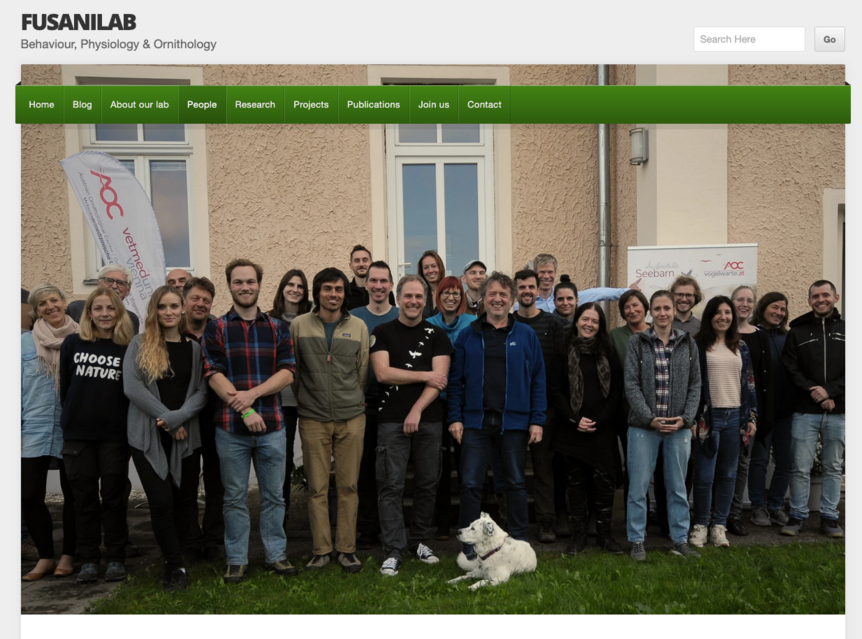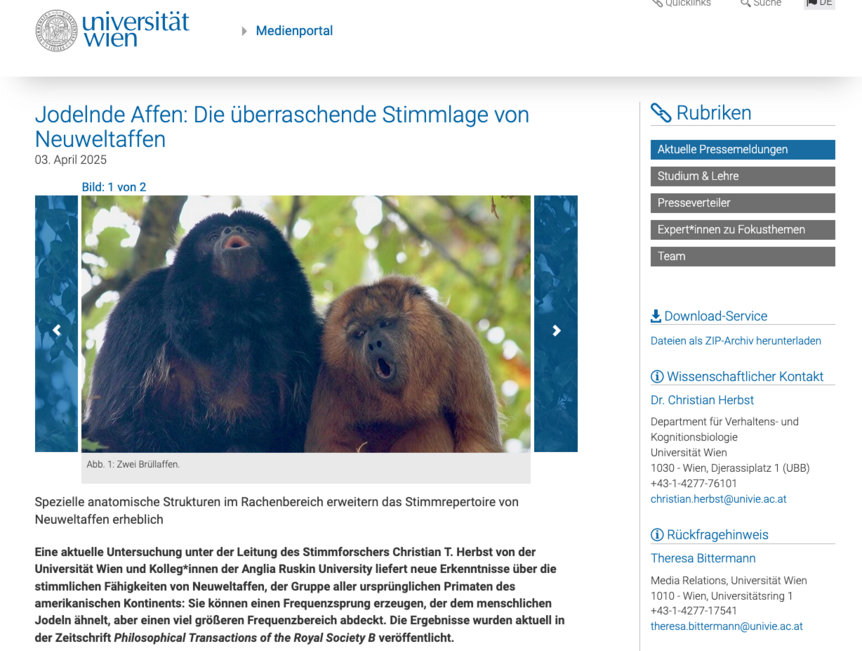News & Events
21.11.2025
22.09.2025
21.07.2025
09.07.2025
Publications
Showing entries 1171 - 1200 out of 1393
Fitch WT, Hagoort P, Friederici AD. Pattern perception and computational complexity: introduction to the special issue. Philosophical Transactions of the Royal Society of London. Biological Sciences. 2012;367(1598):1925-1932.
Marin M, Gingras B, Stewart L. Perception of musical timbre in congenital amusia: Categorization, discrimination and short-term memory. Neuropsychologia. 2012;50(3):367-378.
Fitch WT, Charlton BD, Larkin R, Ellis WAH. Perception of size-related formant information in male koalas (Phascolarctos cinereus). Animal Cognition. 2012;15(5):999-1006.
Huber L, Fitch WT, Westphal Fitch G, Gómez JC. Production and perception rules underlying visual patterns: effects of symmetry and hierarchy. Philosophical Transactions of the Royal Society of London. Biological Sciences. 2012;367:2007-2022.
Herbst C, Duus E, Jers H, Svec J. Quantitative Voice Class Assessment of Amateur Choir Singers: A Pilot Investigation. International Journal of Research in Choral Singing (IJRCS). 2012;4(1):47-59.
Huber L, Wilkinson A. Radial-arm maze navigation of the red-footed
tortoises (Geochelone carbonaria). Journal of Comparative Psychology. 2012;126(3):305-317.
Herbst C, Fitch WT, Stöger-Horwath A. Rätsel um tiefe Töne der Elefanten gelöst. Der Standard. 2012.
Schwab C, Swoboda R, Kotrschal K, Bugnyar T. Recipients Affect Prosocial and Altruistic Choices in Jackdaws, Corvus monedula. PLoS ONE. 2012;7(4). doi: 10.1371/journal.pone.0034922
Fischer S. Reduction in Predator Defense in the Presence of Neighbors in a Colonial Fish. PLoS ONE. 2012.
Massen JJM. Sneaky monkeys: an audience effect on rhesus macaque (Macaca mulatta) sexual behaviour. American Journal of Primatology. 2012;74:217-228. doi: 10.1002/ajp.21988
Braun A, Bugnyar T. Social bonds and rank acquisition in raven nonbreeder aggregations. Animal Behaviour. 2012;84(6):1507-1515.
Braun A, Walsdorff T, Fraser O, Bugnyar T. Socialized sub-groups in a temporary stable raven flock? Journal of Ornithology. 2012;153(1):97-104. doi: 10.1007/s10336-011-0810-2
Steurer M, Stephan C, Aringer J, Berger W, Aust U. The Multi-Stimulus box: An innovative learning device for the comparative study on object perception and recognition with various types of stimuli. Behavior Research Methods. 2012;44(3):725-732. doi: 10.3758/s13428-011-0179-4
Böckle M. The Notion of Knowledge in Cognitive Ethology: Cognitive Ethology in the Realm of the Red Queen. AV Akademikerverlag, 2012. 124 p.
Tebbich S, Stankewitz S, Teschke I. The Relationship Between Foraging, Learning Abilities and Neophobia in Two Species of Darwin’s Finches. Ethology. 2012;118(2):135-146. doi: 10.1111/j.1439-0310.2011.02001.x
Steurer M, Aust U, Huber L. The Vienna comparative cognition technology (VCCT): An innovative operant conditioning system for various species and experimental procedures. Behavior Research Methods. 2012;44(4):909-918. doi: 10.3758/s13428-012-0198-9
Tebbich S, Teschke I, Cartmill EA, Stankewitz S. Use of a barbed tool by an adult and a juvenile woodpecker finch (Cactospiza pallida). Behavioural Processes. 2012;89(2):166-171.
Stobbe N, Westphal Fitch G, Aust U, Fitch WT. Visual artificial grammar learning: comparative research on humans, kea (Nestor notabilis) and pigeons (Columba livia). Philosophical Transactions of the Royal Society of London. Biological Sciences. 2012;367(1598, SI):1995-2006. doi: 10.1098/rstb.2012.0096
Showing entries 1171 - 1200 out of 1393






